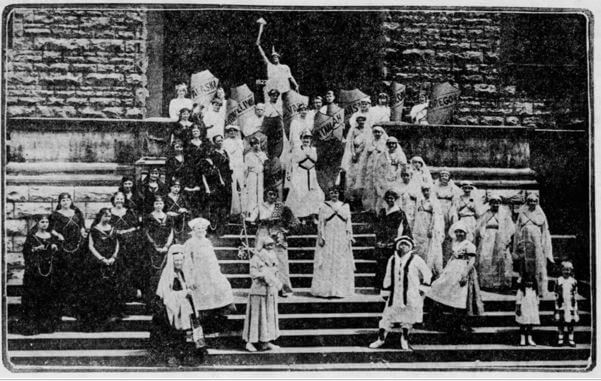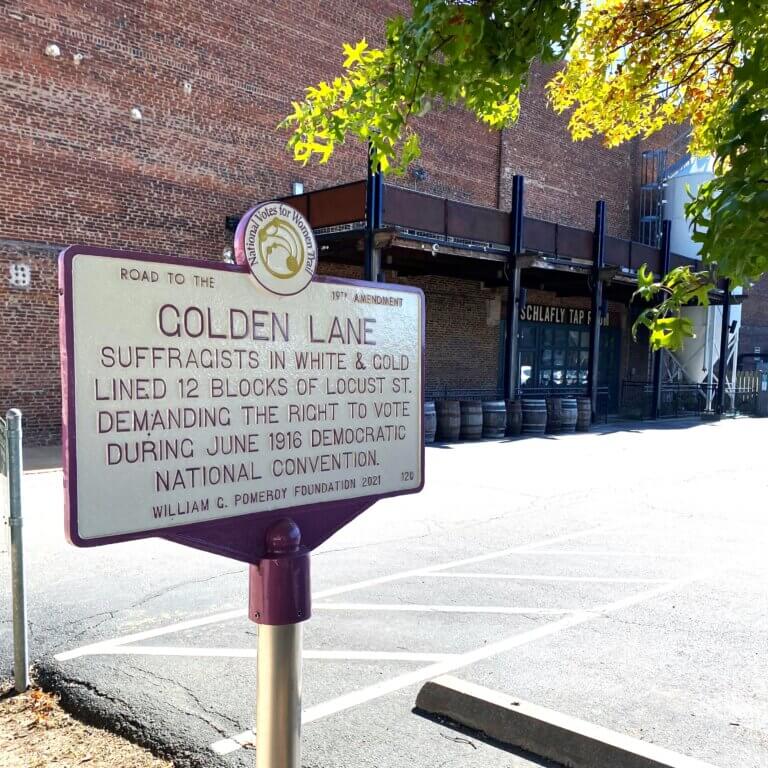GOLDEN LANE
- Program
- Subject
- Location
- Lat/Long
- Grant Recipient
-
National Votes for Women Trail
-
Event
- 2108 Locust St, St. Louis, MO 63103, USA
- 38.633215, -90.209726
-
National Collaborative for Women's History Sites
GOLDEN LANE
Inscription
GOLDEN LANESUFFRAGISTS IN WHITE & GOLD
LINED 12 BLOCKS OF LOCUST ST.
DEMANDING THE RIGHT TO VOTE
DURING JUNE 1916 DEMOCRATIC
NATIONAL CONVENTION.
WILLIAM G. POMEROY FOUNDATION 2021
On June 14, 1916, thousands of suffragists dressed in white with gold “Votes for Women” sashes lined Locust Street in St. Louis, Missouri in a “walkless, talkless” suffrage demonstration referred to as the “Golden Lane.” The line of suffragists stretched for 12 city blocks, beginning at the corner of North 12th Street (later named North Tucker Boulevard) and Locust Street and ending at the Coliseum on the corner of Jefferson Avenue and Locust Street.
The “Golden Lane” coincided with the opening day of the 1916 Democratic National Convention being held at the Coliseum in St. Louis. The demonstration was organized by the Missouri Equal Suffrage Association and Florence Maule Cooley Updegraff of New York. Women of the 28 St. Louis wards volunteered to line Locust Street, and suffragists from around the country were present, including the leadership of the major suffrage organizations. The suffragists were demanding that the Democratic Party adopt a women’s suffrage plank in its platform, and delegates to the Democratic National Convention had to pass through the “Golden Lane” on their way to the convention hall.
Included in the demonstration was a “suffrage tableau” on the steps of the building on the corner of 19th and Locust Streets. The tableau featured suffragists dressed in white representing the states which had already secured women’s suffrage. There were additional representations of the states that had achieved partial suffrage and the states that did not yet have women’s suffrage, including Missouri, were represented by women dressed in black with their hands chained.
The “Golden Lane” proved a success, with the 1916 Democratic National Platform endorsing the extension of suffrage to women “upon the same terms as to men.” However, it was not until June 4, 1919 that the United States Congress passed the Nineteenth Amendment which reads, “The right of citizens of the United States to vote shall not be denied or abridged by the United States or by any state on account of sex.” On July 3, Missouri ratified the Nineteenth Amendment and by August 1920, the necessary 36 states had ratified the amendment, securing women’s right to vote across the United States.



